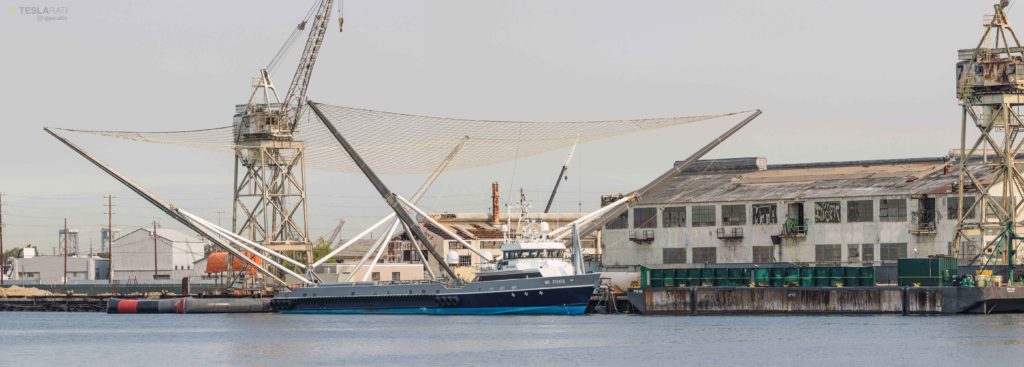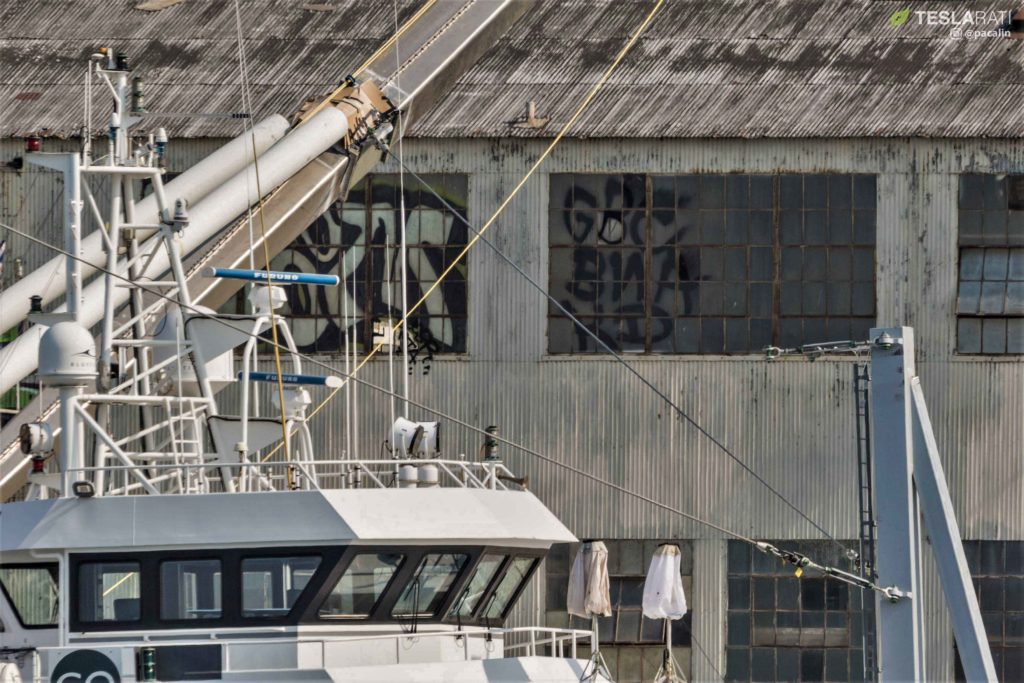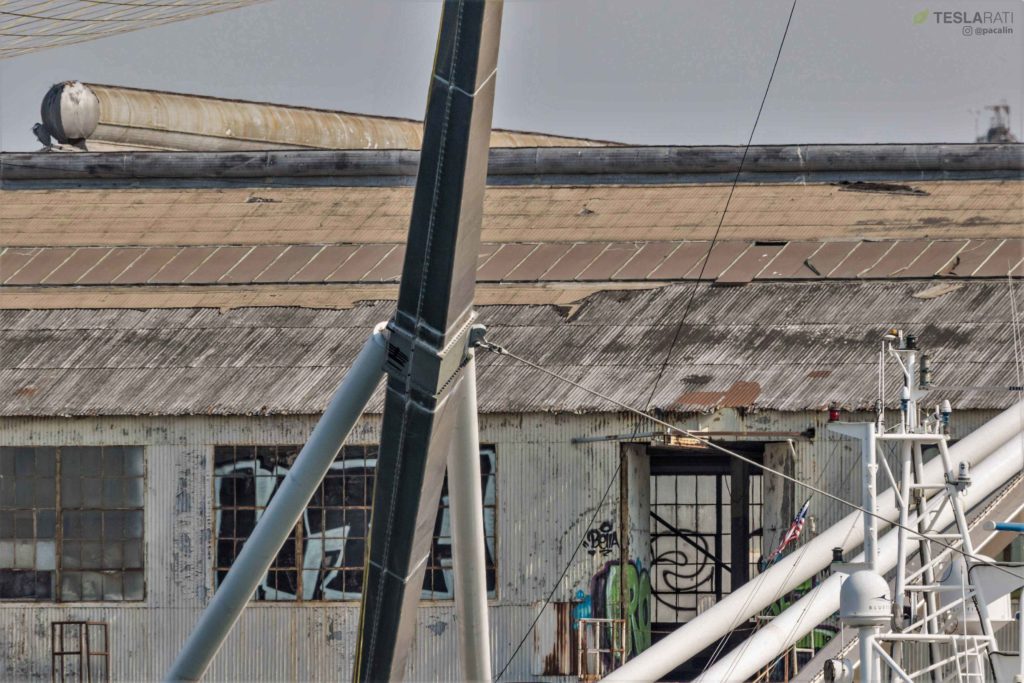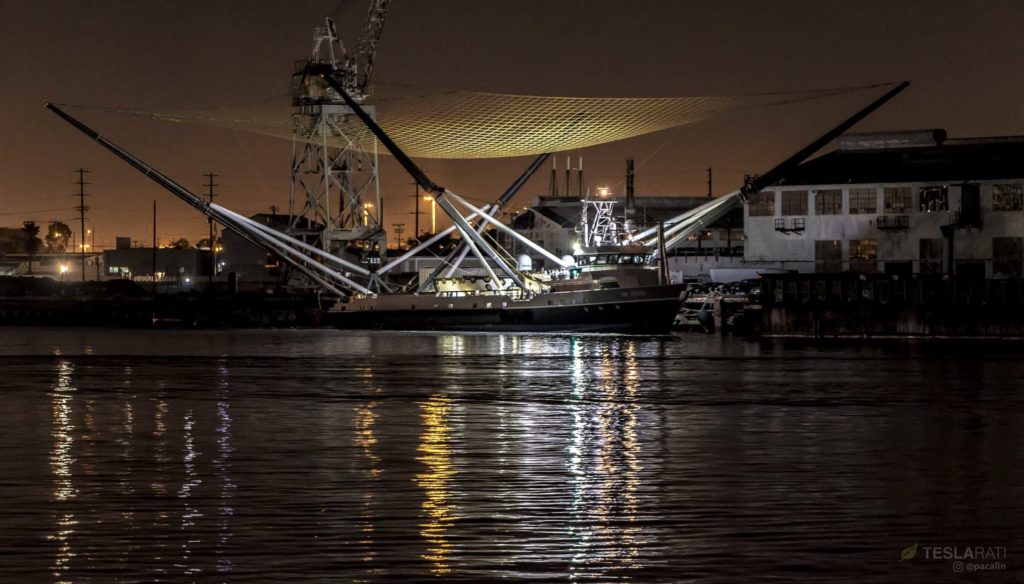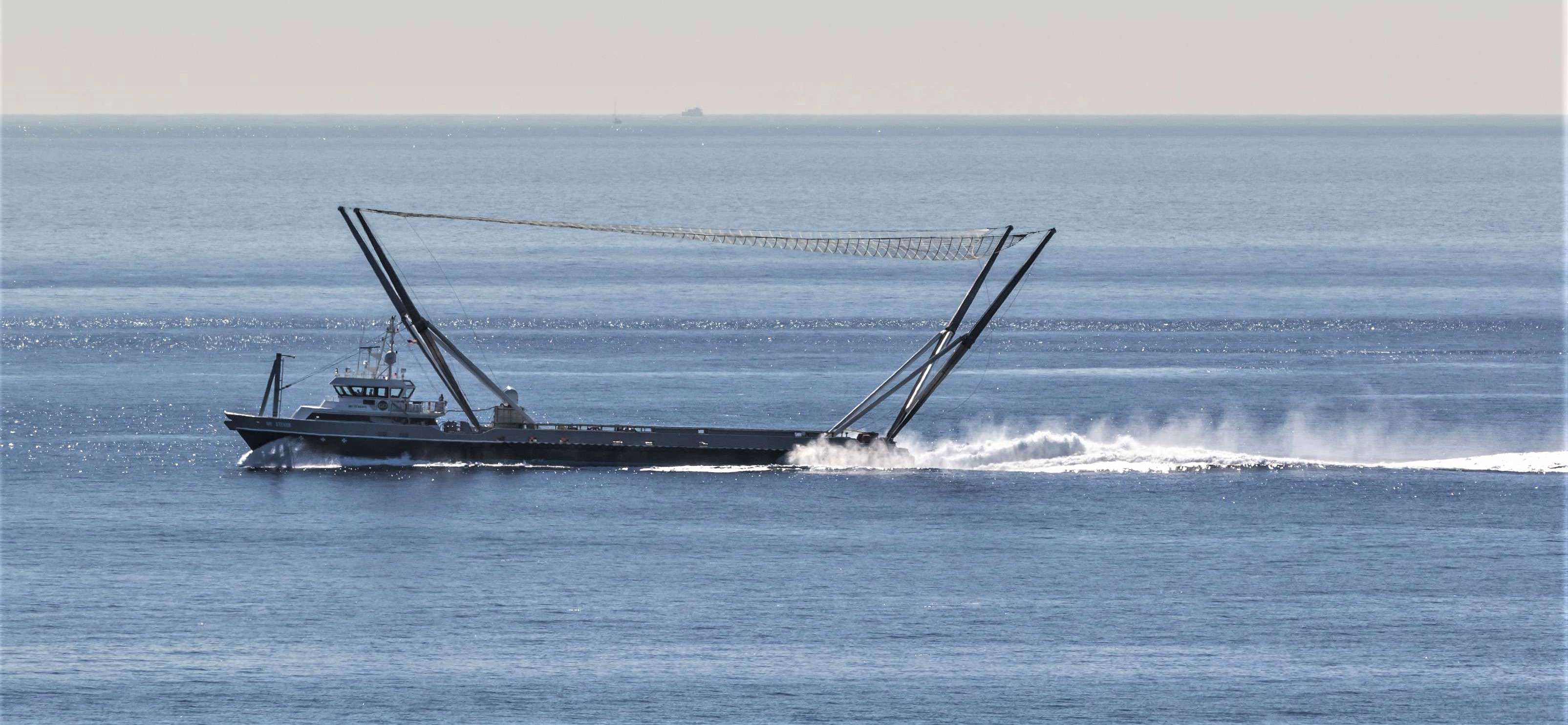

News
SpaceX Falcon fairing recovery vessel Mr. Steven tests out new limbs at sea
After a week or so spent installing a new and moderately ambiguous arm on the nose of Falcon fairing recovery vessel Mr. Steven, SpaceX’s recovery crew performed a number of high-speed sea trials a few miles off the shore of Port of Los Angeles, testing out something.
Just a few days later, Mr. Steven returned to the general region surrounding Catalina Island, where – by all appearances – SpaceX technicians performed the most recent Falcon fairing drop/catch test. Using a helicopter to pick up the test-dedicated fairing half from a barge, eventually dropping it from around 10,000 feet, this offers Mr. Steven a much higher volume of controlled attempts at both catching a parasailing fairing and optimizing the technology and recovery methods involved.
Mr Steven arriving back at port after some sea trials (with some new hardware near his nose). Such an elegant ship. The drop-test fairing is back in view on the dock as well. Soooooon……#spacex #mrsteven @Teslarati pic.twitter.com/qsmEy2Kk2a
— Pauline Acalin (@w00ki33) November 12, 2018
Over the last few weeks, Teslarati photographer Pauline Acalin has reliably kept up with Mr. Steven, documenting a variety of recent physical changes to the vessel. Most notably, these changes include the installation of a visible and quite curious stanchion (or arm) at the ship’s aft tip (nose). Simply due to a lack of any real information about the experiences of operating Mr. Steven and attempting to catch Falcon fairings, it’s all but impossible to know for sure what this new limb accomplishes or why it was needed in the first place.
Armed to the teeth
More clear are general visual observations and the reasonable extrapolations that can be derived from them. At the simplest level, this new limb is clearly well-reinforced, at least no less so than any of Mr. Steven’s other arms and attachment points. Aside from a basic off-the-shelf ladder for crew and technician access, the stanchion plays host to four basic swinging arms with what looks like one or maybe one and a half degrees of freedom, allowing them to pivot roughly 180 degrees along the plane of the angle they were installed at.
- An overview of Mr. Steven on November 10th, shortly after his new arm’s cables were attached. (Pauline Acalin)
- A good closeup of Mr. Steven’s new limb and its associated cables, cable linkages, and arm attachments. (Pauline Acalin, 11/10/18)
- A different view of the arm-cable attachment fixtures. (Pauline Acalin)
Secured to the ends of those four simple arms are four heavy-duty coiled metal cables, themselves attached to the center of Mr. Steven’s two foremost arms (two cables per arm). Curiously, the ship’s Nov. 12 sea trials were conducted with just the bottom two cables attached to each respective arm, visible in photos of the outing. Upon returning from a Nov. 14 fairing drop-and-catch test, both upper and lower cable sets were seen attached to his aft arms. During the nearby sea trials, no clearly abnormal behavior – compared against previous trials at similar speeds and the same location – was observed, although the new metal cables were visibly taut or nearly so.
Given just how seemingly nuanced the utility of this new arm and cable combo seems to be, a few obvious conclusions and possible explanations can be drawn. Perhaps Mr. Steven experiences inconvenient arm bouncing while sailing at high speeds, particularly in high speeds, and holding his arms down serves to grease the metaphorical gears of fairing recovery. Maybe the recovery net – stretched between four large arms – is tensioned more than SpaceX fairing recovery engineers and technicians would like, partially shrinking the usable catching area by pulling each arm towards the center. Even more nuanced still, it may be the case that these new tensioning steel cables and stanchion make it easier for fairing halves to be processed after landing in Mr. Steven’s net, allowing the crew to accurately and rapidly move the fairing to an optimal section of the net.
- (Pauline Acalin)
- Note the duo of cables connected to the arm attachment jig. (Pauline Acalin)
More questions than answers
Regardless, none of these best-case, simple explanations for the new hardware satisfactorily mesh with the known facts surrounding Mr. Steven and Falcon fairing recovery in general. For any of the above scenarios to be true, one must essentially assume that SpaceX has already nailed down fairing recovery and catches or believes that the path to solving those problems is almost totally clear of obstacles. If not, it would feel more than a little like putting the cart before the horse (or the fairing before the net) to be optimizing Mr. Steven for operations that are – as of yet – out of reach.
If SpaceX were so close to closing the fairing recovery gap, one would generally expect Mr. Steven to attempt fairing recoveries after all true Falcon 9 launches while also performing controlled drop test catch attempts. However, no such attempt was made after the October 7 launch of SAOCOM-1A and – according to CEO Elon Musk – Mr. Steven will not be attempting to catch Falcon 9’s fairing(s) after the imminent launch of SSO-A, expected to occur sometime after Thanksgiving (later this week).
Will try again next month
— Elon Musk (@elonmusk) November 14, 2018
For prompt updates, on-the-ground perspectives, and unique glimpses of SpaceX’s rocket recovery fleet check out our brand new LaunchPad and LandingZone newsletters!
Elon Musk
Tesla investors will be shocked by Jim Cramer’s latest assessment
Jim Cramer is now speaking positively about Tesla, especially in terms of its Robotaxi performance and its perception as a company.
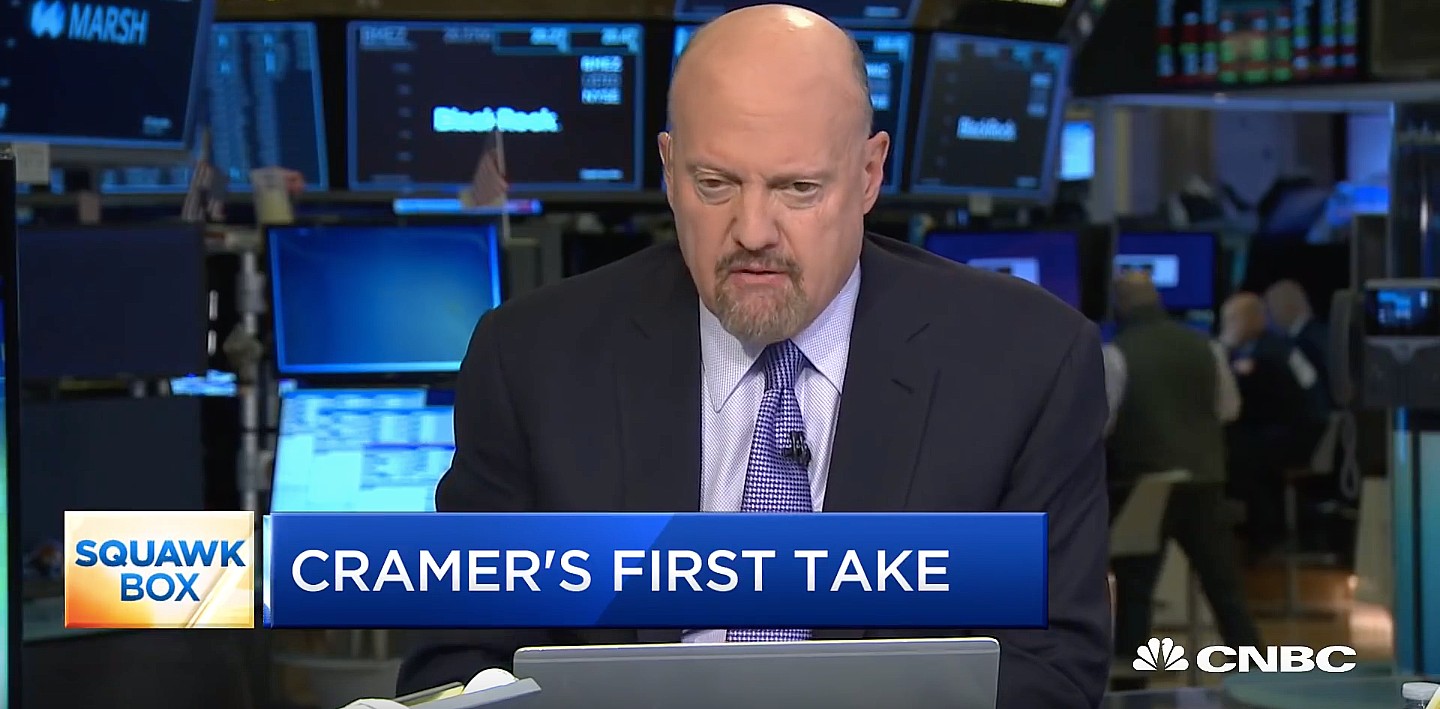
Tesla investors will be shocked by analyst Jim Cramer’s latest assessment of the company.
When it comes to Tesla analysts, many of them are consistent. The bulls usually stay the bulls, and the bears usually stay the bears. The notable analysts on each side are Dan Ives and Adam Jonas for the bulls, and Gordon Johnson for the bears.
Jim Cramer is one analyst who does not necessarily fit this mold. Cramer, who hosts CNBC’s Mad Money, has switched his opinion on Tesla stock (NASDAQ: TSLA) many times.
He has been bullish, like he was when he said the stock was a “sleeping giant” two years ago, and he has been bearish, like he was when he said there was “nothing magnificent” about the company just a few months ago.
Now, he is back to being a bull.
Cramer’s comments were related to two key points: how NVIDIA CEO Jensen Huang describes Tesla after working closely with the Company through their transactions, and how it is not a car company, as well as the recent launch of the Robotaxi fleet.
Jensen Huang’s Tesla Narrative
Cramer says that the narrative on quarterly and annual deliveries is overblown, and those who continue to worry about Tesla’s performance on that metric are misled.
“It’s not a car company,” he said.
He went on to say that people like Huang speak highly of Tesla, and that should be enough to deter any true skepticism:
“I believe what Musk says cause Musk is working with Jensen and Jensen’s telling me what’s happening on the other side is pretty amazing.”
Tesla self-driving development gets huge compliment from NVIDIA CEO
Robotaxi Launch
Many media outlets are being extremely negative regarding the early rollout of Tesla’s Robotaxi platform in Austin, Texas.
There have been a handful of small issues, but nothing significant. Cramer says that humans make mistakes in vehicles too, yet, when Tesla’s test phase of the Robotaxi does it, it’s front page news and needs to be magnified.
He said:
“Look, I mean, drivers make mistakes all the time. Why should we hold Tesla to a standard where there can be no mistakes?”
It’s refreshing to hear Cramer speak logically about the Robotaxi fleet, as Tesla has taken every measure to ensure there are no mishaps. There are safety monitors in the passenger seat, and the area of travel is limited, confined to a small number of people.
Tesla is still improving and hopes to remove teleoperators and safety monitors slowly, as CEO Elon Musk said more freedom could be granted within one or two months.
News
Tesla launches ultra-fast V4 Superchargers in China for the first time
Tesla has V4 Superchargers rolling out in China for the first time.
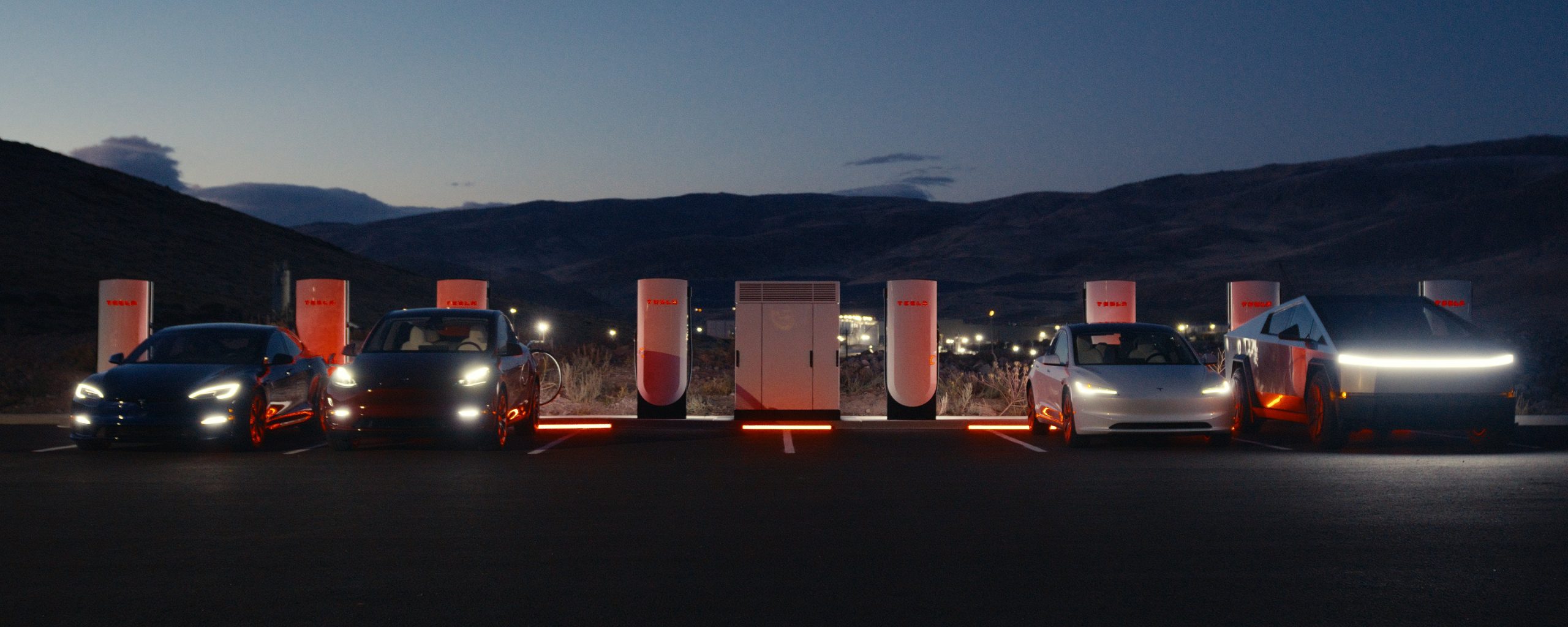
Tesla already has nearly 12,000 Supercharger piles across mainland China. However, the company just initiated the rollout of the ultra-fast V4 Superchargers in China for the first time, bringing its quick-charging piles to the country for the first time since their launch last year.
The first batch of V4 Superchargers is now officially up and running in China, the company announced in a post on Chinese social media outlet Weibo today.
The company said in the post:
“The first batch of Tesla V4 Superchargers are online. Covering more service areas, high-speed charging is more convenient, and six-layer powerful protection such as rain and waterproof makes charging very safe. Simultaneously open to non-Tesla vehicles, and other brands of vehicles can also be charged. There are more than 70,000 Tesla Superchargers worldwide. The charging network layout covers 100% of the provincial capitals and municipalities in mainland China. More V4 Superchargers will be put into use across the country. Optimize the charging experience and improve energy replenishment efficiency. Tesla will accompany you to the mountains, rivers, lakes, and seas with pure electricity!”
The first V4 Superchargers Tesla installed in China are available in four cities across the country: Shanghai, Zhejiang, Gansu, and Chongqing.
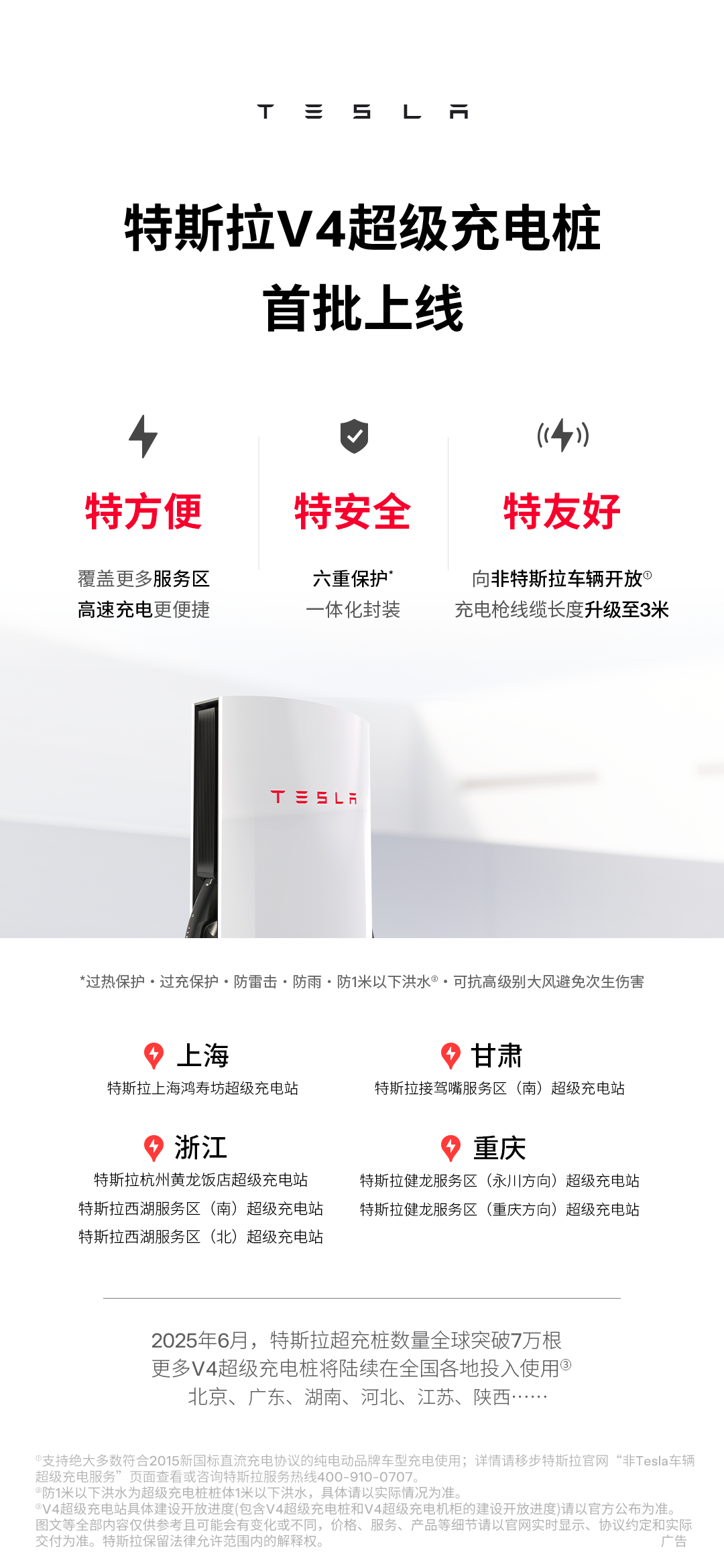
Credit: Tesla China
Tesla has over 70,000 Superchargers worldwide. It is the most expansive and robust EV charging network in the world. It’s the main reason why so many companies have chosen to adopt Tesla’s charging connector in North America and Europe.
In China, some EVs can use Tesla Superchargers as well.
The V4 Supercharger is capable of charging vehicles at speeds of up to 325kW for vehicles in North America. This equates to over 1,000 miles per hour of charging.
Elon Musk
Elon Musk hints at when Tesla could reduce Safety Monitors from Robotaxi
Tesla could be reducing Safety Monitors from Robotaxi within ‘a month or two,’ CEO Elon Musk says.

Elon Musk hinted at when Tesla could begin reducing Safety Monitors from its Robotaxis. Safety Monitors are Tesla employees who sit in the front passenger seat during the driverless rides, and are there to ensure safety for occupants during the earliest rides.
Tesla launched its Robotaxi fleet in Austin last Sunday, and after eight days, videos and reviews from those who have ridden in the driverless vehicles have shown that the suite is safe, accurate, and well coordinated. However, there have been a few hiccups, but nothing that has put anyone’s safety in danger.
A vast majority — close to all of the rides — at least according to those who have ridden in the Robotaxi, have been performed without any real need for human intervention. We reported on what was the first intervention last week, as a Safety Monitor had to step in and stop the vehicle in a strange interaction with a UPS truck.
Watch the first true Tesla Robotaxi intervention by safety monitor
The Tesla and UPS delivery truck were going for the same street parking space, and the Tesla began to turn into it. The UPS driver parallel parked into the spot, which was much smaller than his truck. It seemed to be more of an instance of human error instead of the Robotaxi making the wrong move. This is something that the driverless cars will have to deal with because humans are aggressive and sometimes make moves they should not.
The Safety Monitors have not been too active in the vehicles. After all, we’ve only seen that single instance of an intervention. There was also an issue with the sun, when the Tesla braked abnormally due to the glare, but this was an instance where the car handled the scenario and proceeded normally.
With the Robotaxi fleet operating impressively, some are wondering when Tesla will begin scaling back both the Safety Monitors and Teleoperators that it is using to ensure safety with these early rides.
CEO Elon Musk answered the inquiry by stating, “As soon as we feel it is safe to do so. Probably within a month or two.”
As soon as we feel it is safe to do so.
Probably within a month or two. We continue to improve the Tesla AI with each mile driven.
— Elon Musk (@elonmusk) June 30, 2025
Musk’s response seems to confirm that there will be fewer Teleoperators and Safety Monitors in the coming months, but there will still be some within the fleet to ensure safety. Eventually, that number will get to zero.
Reaching a point where Tesla’s Robotaxi is driverless will be another significant milestone for the company and its path to fully autonomous ride-sharing.
Eventually, Tesla will roll out these capabilities to consumer-owned vehicles, offering them a path to generate revenue as their car operates autonomously and completes rides.
For now, Tesla is focusing on perfecting the area of Austin where it is currently offering driverless rides for just $4.20 to a small group of people.
-

 News5 days ago
News5 days agoTesla Robotaxi’s biggest challenge seems to be this one thing
-
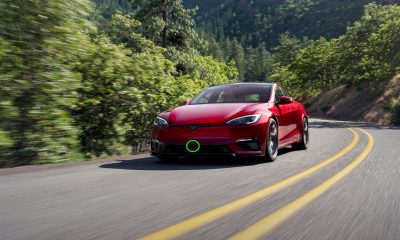
 News2 weeks ago
News2 weeks agoTesla confirms massive hardware change for autonomy improvement
-

 Elon Musk2 weeks ago
Elon Musk2 weeks agoElon Musk slams Bloomberg’s shocking xAI cash burn claims
-

 News2 weeks ago
News2 weeks agoTesla China roars back with highest vehicle registrations this Q2 so far
-
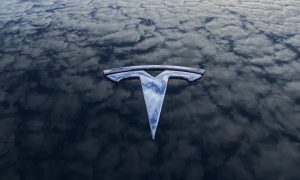
 News2 weeks ago
News2 weeks agoTesla features used to flunk 16-year-old’s driver license test
-

 News2 weeks ago
News2 weeks agoTexas lawmakers urge Tesla to delay Austin robotaxi launch to September
-

 News2 weeks ago
News2 weeks agoTesla dominates Cars.com’s Made in America Index with clean sweep
-

 News2 weeks ago
News2 weeks agoTesla’s Grok integration will be more realistic with this cool feature

